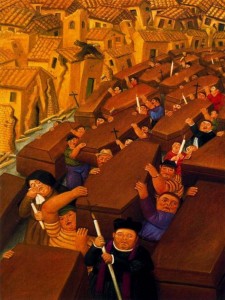 Grandin, Greg and Gilbert M. Joseph, Eds. 2010. A Century of Revolution: Insurgent and Counterinsurgent Violence During Latin America’s Long Cold War. Durham, NC: Duke University Press. [Selections]
Grandin, Greg and Gilbert M. Joseph, Eds. 2010. A Century of Revolution: Insurgent and Counterinsurgent Violence During Latin America’s Long Cold War. Durham, NC: Duke University Press. [Selections]
I wish I’d had more time to devote to A Century of Revolution edited by Greg Grandin and Gilbert Joseph. Unfortunately, I had to skip around, but I’ll certainly come back to this book for years. I’ll definitely give it the read it deserves soon. The title of the book itself is significant because the authors argue that periodization of the Cold War for Latin America should be broadened, repositioning its start at least with the first spark of the Mexican Revolution, if not before (1898), while ending with Central America’s conflicts of the 1980s. Latin America’s “Long Cold War” is defined not so much by the superpower contest between Russia and the United States (the Cold War proper) as it is by U.S. efforts at political containment. Beyond this, though deeply related, is the editors’ demand that political violence be historicized; otherwise, it ends up being cast as beyond explanation and analysis, ineffable or (worse) aestheticized.
Overdetermining the region’s century of revolution was the “attempt by the United States (and its local clients) to contain insurgencies that challenged post-(or neo-)colonial social formations predicated on dependent economies and class, ethnic, and gender inequality” (402). One of the more memorable points the book drives home is that counterrevolution and counterinsurgency are themselves much more than rearguard, paranoid actions. They are this, but they are also much, much more. They are dynamic and forward-looking political projects that can’t be understood in isolation from the revolutionary movements (real-and-imagined) they aim to rein in and in most cases annihilate.
The editors, as their view of the Cold War would suggest, are also attentive to the multi-scalar politics of political violence (both in terms of space and time). As far as time, all the essays reveal the contingencies and structures surrounding events and conjunctures. The editors emphasize the sequence and chronology of events, too. And spatially, most contributions are also well aware of the regional, continental, deeply local, transnational and global dynamics and relations at work along those same time scales.
The editors made a clear choice and expended considerable effort constructing a collective conceptual framework for the book, drawing entirely on historian Arno Mayer’s work. This effort was more successful in some places more than others; at times it felt forced, or just token. Grandin outlines this conceptual framework—along with his modifications—in his brilliant introduction. Mayer saw modern European history as one of containment, first of liberalism and then of socialism. Battling for containment was messy and bloody and fought out through clashes, conflict, and coalitions. Reaction to political upheavals, both domestic and international, drove coalitional politics through ideology, interests, and sentiment. But these reactions quickly cannibalized, feeding off their own metabolism spinning out of control, leading to increasingly disproportionate violent backlashes. Grandin sums up Mayer’s framework on political terror with three conceptual coordinates: clash, contingency, and passion. An insurgency clashes against the incumbent system it wants to dismantle in a battle beset, conditioned, and created by the open contingency of history and politics, all of which is fused by and infused with passionate experience and interpretation. But the emphasis is on counterinsurgency’s over-sized reaction to exaggerated threats, and, contrary to whitewashed dos demonios accounts, the left rarely responded in kind to the terrors unleashed by the right.
The history of twentieth-century revolutionary and counterrevolutionary violence provides a sociologically nuanced view of the chronological unfolding of ideological hardening and polarization, one that refuses a tautological positioning of ideological radicalism as the cause of radicalization. It forces an appreciation of the catalytic power of political reaction to breed ever more accelerating rhythms of frustration, fear, and extremism. Far from being unfathomable, terror in Latin America is so politically recognizable—in relation to enforcing domination, to generating and maintaining social exclusion, and to propelling historical change—[that it’s mostly taken for granted by many scholars]. (11)
As for my own work, I particularly liked Grandin’s description of counterinsurgency: “Counterinsurgency, above all else, is choreography” (3). He uses it in reference to the coordination of policing and military affairs; I find it as a useful descriptor of how counterinsurgency works through material, symbolic-ideological, and everyday dimensions that are always, everywhere spatially constituted.
I’ll come back to revisit some of the individual essays in the book soon.

Pingback: Geographies of the Outlaw | Territorial Masquerades